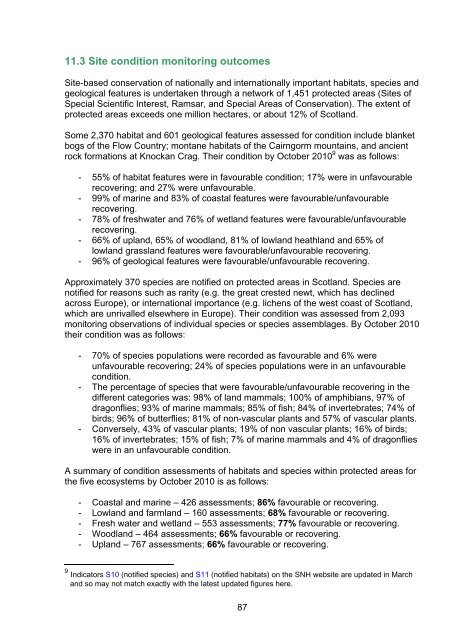Scotland's Wildlife â an assessment of biodiversity in 20
Scotland's Wildlife â an assessment of biodiversity in 20
Scotland's Wildlife â an assessment of biodiversity in 20
Create successful ePaper yourself
Turn your PDF publications into a flip-book with our unique Google optimized e-Paper software.
11.3 Site condition monitor<strong>in</strong>g outcomes<br />
Site-based conservation <strong>of</strong> nationally <strong>an</strong>d <strong>in</strong>ternationally import<strong>an</strong>t habitats, species <strong>an</strong>d<br />
geological features is undertaken through a network <strong>of</strong> 1,451 protected areas (Sites <strong>of</strong><br />
Special Scientific Interest, Ramsar, <strong>an</strong>d Special Areas <strong>of</strong> Conservation). The extent <strong>of</strong><br />
protected areas exceeds one million hectares, or about 12% <strong>of</strong> Scotl<strong>an</strong>d.<br />
Some 2,370 habitat <strong>an</strong>d 601 geological features assessed for condition <strong>in</strong>clude bl<strong>an</strong>ket<br />
bogs <strong>of</strong> the Flow Country; mont<strong>an</strong>e habitats <strong>of</strong> the Cairngorm mounta<strong>in</strong>s, <strong>an</strong>d <strong>an</strong>cient<br />
rock formations at Knock<strong>an</strong> Crag. Their condition by October <strong>20</strong>10 9 was as follows:<br />
- 55% <strong>of</strong> habitat features were <strong>in</strong> favourable condition; 17% were <strong>in</strong> unfavourable<br />
recover<strong>in</strong>g; <strong>an</strong>d 27% were unfavourable.<br />
- 99% <strong>of</strong> mar<strong>in</strong>e <strong>an</strong>d 83% <strong>of</strong> coastal features were favourable/unfavourable<br />
recover<strong>in</strong>g.<br />
- 78% <strong>of</strong> freshwater <strong>an</strong>d 76% <strong>of</strong> wetl<strong>an</strong>d features were favourable/unfavourable<br />
recover<strong>in</strong>g.<br />
- 66% <strong>of</strong> upl<strong>an</strong>d, 65% <strong>of</strong> woodl<strong>an</strong>d, 81% <strong>of</strong> lowl<strong>an</strong>d heathl<strong>an</strong>d <strong>an</strong>d 65% <strong>of</strong><br />
lowl<strong>an</strong>d grassl<strong>an</strong>d features were favourable/unfavourable recover<strong>in</strong>g.<br />
- 96% <strong>of</strong> geological features were favourable/unfavourable recover<strong>in</strong>g.<br />
Approximately 370 species are notified on protected areas <strong>in</strong> Scotl<strong>an</strong>d. Species are<br />
notified for reasons such as rarity (e.g. the great crested newt, which has decl<strong>in</strong>ed<br />
across Europe), or <strong>in</strong>ternational import<strong>an</strong>ce (e.g. lichens <strong>of</strong> the west coast <strong>of</strong> Scotl<strong>an</strong>d,<br />
which are unrivalled elsewhere <strong>in</strong> Europe). Their condition was assessed from 2,093<br />
monitor<strong>in</strong>g observations <strong>of</strong> <strong>in</strong>dividual species or species assemblages. By October <strong>20</strong>10<br />
their condition was as follows:<br />
- 70% <strong>of</strong> species populations were recorded as favourable <strong>an</strong>d 6% were<br />
unfavourable recover<strong>in</strong>g; 24% <strong>of</strong> species populations were <strong>in</strong> <strong>an</strong> unfavourable<br />
condition.<br />
- The percentage <strong>of</strong> species that were favourable/unfavourable recover<strong>in</strong>g <strong>in</strong> the<br />
different categories was: 98% <strong>of</strong> l<strong>an</strong>d mammals; 100% <strong>of</strong> amphibi<strong>an</strong>s, 97% <strong>of</strong><br />
dragonflies; 93% <strong>of</strong> mar<strong>in</strong>e mammals; 85% <strong>of</strong> fish; 84% <strong>of</strong> <strong>in</strong>vertebrates; 74% <strong>of</strong><br />
birds; 96% <strong>of</strong> butterflies; 81% <strong>of</strong> non-vascular pl<strong>an</strong>ts <strong>an</strong>d 57% <strong>of</strong> vascular pl<strong>an</strong>ts.<br />
- Conversely, 43% <strong>of</strong> vascular pl<strong>an</strong>ts; 19% <strong>of</strong> non vascular pl<strong>an</strong>ts; 16% <strong>of</strong> birds;<br />
16% <strong>of</strong> <strong>in</strong>vertebrates; 15% <strong>of</strong> fish; 7% <strong>of</strong> mar<strong>in</strong>e mammals <strong>an</strong>d 4% <strong>of</strong> dragonflies<br />
were <strong>in</strong> <strong>an</strong> unfavourable condition.<br />
A summary <strong>of</strong> condition <strong>assessment</strong>s <strong>of</strong> habitats <strong>an</strong>d species with<strong>in</strong> protected areas for<br />
the five ecosystems by October <strong>20</strong>10 is as follows:<br />
- Coastal <strong>an</strong>d mar<strong>in</strong>e – 426 <strong>assessment</strong>s; 86% favourable or recover<strong>in</strong>g.<br />
- Lowl<strong>an</strong>d <strong>an</strong>d farml<strong>an</strong>d – 160 <strong>assessment</strong>s; 68% favourable or recover<strong>in</strong>g.<br />
- Fresh water <strong>an</strong>d wetl<strong>an</strong>d – 553 <strong>assessment</strong>s; 77% favourable or recover<strong>in</strong>g.<br />
- Woodl<strong>an</strong>d – 464 <strong>assessment</strong>s; 66% favourable or recover<strong>in</strong>g.<br />
- Upl<strong>an</strong>d – 767 <strong>assessment</strong>s; 66% favourable or recover<strong>in</strong>g.<br />
9 Indicators S10 (notified species) <strong>an</strong>d S11 (notified habitats) on the SNH website are updated <strong>in</strong> March<br />
<strong>an</strong>d so may not match exactly with the latest updated figures here.<br />
87
















